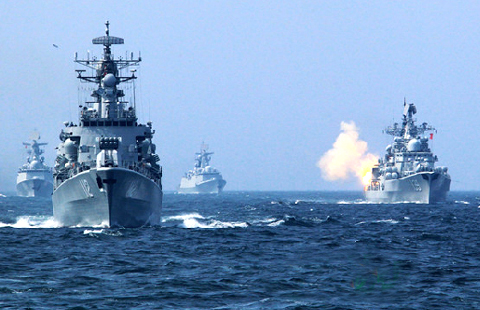Indonesian TV shows objects in Java Sea, may be AirAsia jet debris
Updated: 2014-12-30 14:31
(Agencies)
|
||||||||
About 30 ships and 21 aircraft from Indonesia, Australia, Malaysia, Singapore and South Korea would search up to 10,000 square nautical miles on Tuesday, officials said.
Indonesia's air force spokesman, Hadi Tjahjanto, said authorities would investigate an oil spill seen on Monday, although a separate possible slick turned out to be a reef.
Searchers had investigated several areas where possible debris had been sighted in the water but had found nothing connected to the missing plane, Tjahjanto told Reuters.
Authorities would also investigate reports from fishermen of an explosion on Sunday morning off an island in the area, Tjahjanto added, although dynamite fishing is common in Indonesian waters.
The US military said the USS Sampson, a guided missile destroyer, would be on the scene later on Tuesday.
"We stand ready to assist in any way possible," Pentagon spokesman Mark Wright said.
COULD PLANE HAVE STALLED?
Flight QZ8501 had sought permission from Indonesian air traffic control to ascend to avoid clouds just before it went missing.
Online discussion among pilots has centred on unconfirmed secondary radar data from Malaysia that suggested the aircraft was climbing at a speed of 353 knots, about 100 knots too slow, and that it might have stalled.
The plane, whose engines were made by CFM International, co-owned by General Electric and Safran of France, lacked real-time engine diagnostics or monitoring, a GE spokesman said. Such systems are mainly used on long-haul flights and can provide clues to airlines and investigators when things go wrong.
Officials said the sea in the general search area was only 50 to 100 (150 to 300 feet) metres deep, which should help in finding the plane.
"The Java Sea area where they are now searching isn't even an ocean, it's more of an inland sea," Erik van Sebille, a physical oceanographer at the University of New South Wales in Sydney told Reuters.
"It's so shallow that they may just be able to spot the plane," said van Sebille, noting that sunlight travels through water up to about 100 metres.
Oceanographer Pattiaratchi said debris would normally be expected to float for about 18 days before sinking.
- Smoke allegedly spotted on island as search for missing AirAsia plane expands
- AirAsia flight plan dangerous: Australian aviation expert
- Search area expanded in hunt for AirAsia plane
- AirAsia has little margin for error in crisis over missing jet
- AirAsia's brash CEO now searches for right words
- China offers to help in search for missing AirAsia flight
- Year-end review 2014: Women's issues
- 1st body identified from AirAsia crash handed to family
- Ex-Korean Air 'nut rage' exec arrested
- Top DPRK leader says no reason not to hold high-level north-south talks
- New Year's Eve celebration in Times Square
- Death toll from tropical storm rises to 35 in Philippines

 Happy New Year
Happy New Year
 Happy Yunnan Year from Times Square
Happy Yunnan Year from Times Square
 Let the celebration begin
Let the celebration begin
 New Year's Eve celebration in Times Square
New Year's Eve celebration in Times Square
 Creative colored drawings embrace New Year
Creative colored drawings embrace New Year
 2014 Top news events in China
2014 Top news events in China
 Ten breakthroughs of China's military diplomacy in 2014
Ten breakthroughs of China's military diplomacy in 2014
 Chongqing collective wedding applies for Guinness records
Chongqing collective wedding applies for Guinness records
Most Viewed
Editor's Picks

|

|

|

|

|

|
Today's Top News
Tmall Global's sales rose tenfold in 2014
Yunnan helps rock Times Square celebration
36 killed, 47 injured in Shanghai stampede
US sorghum exports to China hit 19-year high
China's Fosun buys US insurance market
NYC to rename streets for slain policemen
Shares of CNR, CSR surge after merger
Fosun to buy Meadowbrook Insurance for about $433m
US Weekly

|

|





